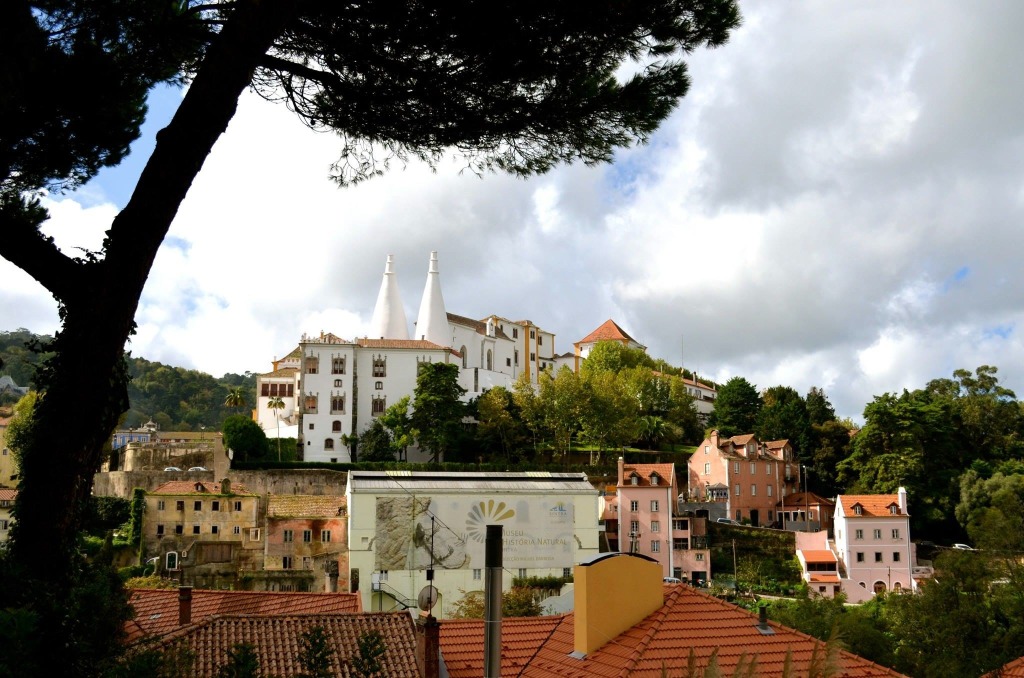Hidden in far-reaching woodland and frequently cloaked in mist, the old town of Sintra has its feet firmly planted in the past and can be found in under an hour’s train ride from the quirky, bar-studded capital of Lisbon.

Sintra, Portugal (Photo: Sylvie Francis. via Flickr)
A Palace of Rainbows
We arrive at the Palacio de Pena on the brink of a storm. The sun has retreated behind a feather down of heavy cloud, which only serves to heighten the vibrancy of this rainbow-hued palace. From the terrace, where we catch our breath from a steep climb, we can just make out the coast – the Atlantic seaside town of Cascais – through a silky sheen of rain. Behind us, a backdrop of rose turrets, blue-tiled facades, domed towers and lemon walls with mink edges.
The Pena National Palace is a symbol of Portuguese culture today, in fact its named one of the seven wonders of Portugal. Sitting in the Serra mountains, it has been painstakingly restored and dates back to the middle ages. Legend tells it was built following the apparition of the Virgin Mary, and in this misty, ethereal place, it doesn’t feel entirely fictional.
The Palacio de Pena began a monastery, before it was damaged by lightening and later seriously impaired by the Great Lisbon Earthquake in the late 18th century. It lay in disarray until a prince, so taken with the spot, rebuilt it in Romantic style to its current glory, to be used as a summer residence for the Portuguese royal family.
The soon-to-be-king planted the land with exotic trees; a labyrinth of paths through towering North American Sequoia, Lawson’s Cypress, Magnolia and Western Red cedar, Chinese Ginkgo, Japanese Cryptomeria, and ferns from the distant continent of Australiasia. The land owned by the prince extended all the way to the Castelo dos Mouros, a 9th century traditional Moorish castle set on a lesser hilltop with battlements clothed in thick ivy, from which one can look up to the palace, stood out like a sore thumb in a sea of greenery.
So striking on the outside, the inside can be nothing but underwhelming, save for a patterned courtyard open to the sky that reminds me of a Moroccan riad. It’s a surprisingly poky museum, a maze of small rooms showcasing fine Meissen porcelain, tromphe l’oeil murals, furniture and paintings – I’m glad to throw the doors open and step back out onto the exposed peak, where a sharp wind sends chills through me.
The Old Town
We head back down forest pathways through the darkness alongside ruined walls quilted in moss and lichen that once protected this kingdom from attack. It’s so green – with just a touch of lime when a persistent sunbeam makes it through the treetop blanket. Cobbled streets lead us back into town, where we catch a late lunch of local cold meats and cheese at the Taverna dos Trovadores. Other notable spots for refueling include the Tacho Real and the pricier Restaurante Seteais, with an extensive wine list.
Sintra has a wealth of 19th century Romantic monuments, which combine to give it UNESCO World Heritage status. It could be any other pretty hillside town but for the intricate roofs and turrets reaching for the clouds – a world straight from the pages of a Grimm fairytale.
At the Old Town’s entrance is the early 20th century neo-Manueline Quinta da Regaleira, the vision of an Italian opera set designer; a closer look reveals carved mythological creatures. The king of fairytales himself, Hans Christian Anderson once visited the National Palace and likened its two cone-shaped turrets to champagne bottles.
Follow in the footsteps of Lord Byron and rest your head at Lawrence’s Hotel, an 18th century mansion with quirky rooms, or for a more luxurious experience there’s the 5* Tivoli Palacio de Seteais with stunning gardens.
For those adverse to the long woodland walk to the Palacio de Pena and Castelo dos Mouros, there’s a slightly heart-stopping local bus that hurtles up and down the steep roads frequently enough. But go early on a weekday for the best experience – high season on a weekend isn’t worth the droves of slow-moving tourists.